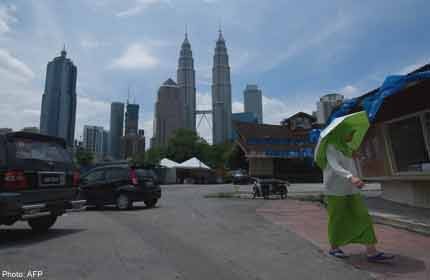$1.6b tunnel to transfer water to KL from Pahang

A TUNNEL almost as long as the length of Singapore, which will be used to carry raw water from Pahang to Kuala Lumpur and Selangor, is being dug underneath mountains and forests in central Malaysia.
The massive project will ensure that the country's most industrialised and populated districts have sufficient water until 2025.
Costing RM3.93 billion (S$1.55 billion), the project will also provide water security for the Greater KL region, which comprises the capital Kuala Lumpur and the southern half of Selangor. Currently, water supplied to this area comes from rivers and reservoirs in Selangor, including the key Selangor River.
In August, hundreds of thousands of people in the Greater KL region were left without water for days, after diesel spilled into a river.
"The project has a two-pronged objective," said Dr Zullkefle Nordin, the director of the Pahang-Selangor raw water transfer project, who is from the Ministry of Energy, Green Technology and Water.
"One is to facilitate future water use," he said in an interview last week. "The other - if something were to happen to Selangor River such as pollution, the Pahang-Selangor scheme would be there as extra security."
Started four years ago, the project involves two Japanese and two Malaysian main contractors. It has not drawn controversial headlines, unlike many other mega projects here. The reason is that most people are aware of its necessity, especially those who went through the severe water shortage of 1998, during the dry season that brought in the haze from Sumatra for the first time.
"I hope the project will supply us with water for a long time. No one wants to go through 1998 again," said housewife Roziah Mazlan, 45. During the shortage, the KL resident and her neighbours had to queue up with pails to carry water back from water-tanker lorries.
The project is a green initiative - the forest reserves in central Peninsular Malaysia have not been touched by the underground works.
"In Japan, many tunnels are like that. You keep your monkeys, you keep your trees, on top," said Datuk Loo Took Gee, the ministry's secretary-general. "This is environmentally friendly."
The Greater KL region, which has a population of about six million, consumes 4.465 million cubic m of water a day. The figure is set to rise to 5.371 million cu m by 2030.
In contrast, Singapore, which puts great effort into water conservation, consumes about 1.73 million cu m a day, according to the Ministry of the Environment and Water Resources website.
Once completed, the water-transfer inlet pipes in Karak, Pahang, and the underground tunnel will cover a combined stretch of 44.6 km - just slightly less than the distance from Tuas to Changi.
The water for KL and Selangor will come from Semantan River and the new Kelau Dam in Pahang. It will flow through the inlet pipes and into the tunnel, which will have a diameter of 5.2m. The water will come out at Hulu Langat, south-east of KL, when the project is completed in May next year.
Unfortunately, this is where politics has intruded.
Selangor fell to the opposition Pakatan Rakyat alliance in the 2008 general election. There were plans to build a RM4 billion plant, called Langat 2, to treat the Pahang water, and have it ready by next year, but they have not come to pass because the Selangor government refused to sign off on the development order.
The reason is that Selangor wants to control all the water assets in the KL-Selangor region - reservoirs, treatment plants and distribution pipes. Currently, they are jointly owned by the federal government and Selangor state.
The Langat 2 plant will probably be ready in 2017 instead, as ongoing talks to sell the water assets to Selangor are expected to be completed by the end of the year.
The talks are proceeding "very aggressively", said Madam Loo, who is chairing the meetings.
"Without Langat 2, this project is a white elephant. The treatment plant is part and parcel of the project. We must find a solution to ensure a win-win situation for all."
reme@sph.com.sg

Get a copy of The Straits Times or go to straitstimes.com for more stories.